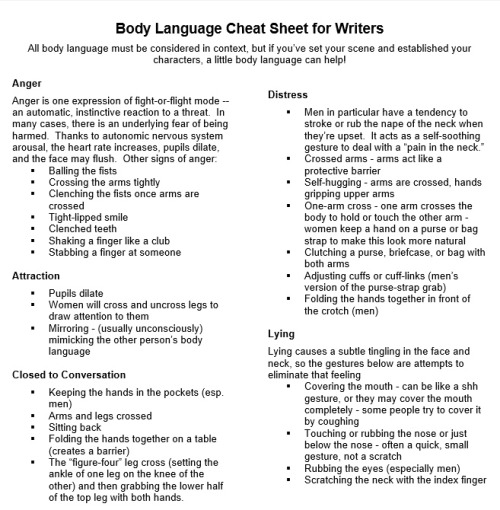Helpful Grammar Tip! Farther Is For Physical Distance, Further Is For Metaphorical Distance, And Father
helpful grammar tip! farther is for physical distance, further is for metaphorical distance, and father is for emotional distance!
More Posts from Writersreferencez and Others
Instead of "Looked", consider
glanced
peered
gazed
stared
watched
observed
examined
scrutinized
surveyed
glimpsed
eyed
beheld
inspected
checked
viewed
glanced at
regarded
noticed
gawked
spied
Writing a Relationship Your Readers Will Ship
Relationships, especially in beginner writer’s works, have a tendency to feel forced. Even in some popular and famous works of fiction, the relationship doesn’t feel natural. It seems like a boring afterthought which the writer added in at the last minute. Far too often, I find myself completely indifferent to a character’s romantic life. A good romance in a story will give the reader a bit of second-hand infatuation. They’ll root for the relationship, beg for it. If the romance is well written, you can make a reader smile and blush just by reading a few sentences. When done properly, it can even compensate for a weak and cliché plot.
But first, decide whether the romance is needed. If you’re adding a character to the plot simply for the sake of being a love interest, it’s probably not a needed romance. You can still add it, of course, but it will be much harder to keep your story focused on the central plot.
Step One Make sure the characters have chemistry.
The characters should compliment each other’s personalities. If he’s loud, stubborn, and aggressively opinionated, a more tranquil and soft-spoken love interest would suit him well. Two headstrong people wouldn’t be likely to have a lasting relationship in real life, unless they (impossibly) agreed upon every subject. But, there should be some similarities. While opposites do attract, polar opposites will not and the whole relationship will feel forced. The characters should have something in common. It could be morals, a parallel backstory, the same motivations, whatever. As long as there’s a reason for them to be drawn to each other, there’s potential.
Step Two Slow burn ships are fantastic.
Don’t make your characters fall in love right off the bat. There can be attraction, of course, but genuine feelings of true love don’t happen instantly. Your characters should become closer as people, feel at ease around each other, and truly know the other before they fall head-over-heels. The readers will crave the relationship far more, like dangling a treat right in front of a dog’s nose, but keep pulling it away. Teasing is a beautiful thing.
Find ways of showing (NOT TELLING) the characters are falling for each other. Have them stand up for one another, be protective. Have them break their own normal routine for the other. For example, a callous, guarded character could lower their walls for a moment if their love interest needs emotional support. These scenes can be awkward for the character changing their typical behavior and that discomfort can demonstrate how much they care for the other, altering their own selves for the other’s benefit.
Howeve, make sure that you combine these cute emotional moments with distance. Make the characters deny their true feelings or even distance themselves from their love interest upon discovering their feelings. The more the characters long for each other, the more the reader will long for them to be together. Build barriers between them for your characters to have to work to knock down. Keep them close, but maintain that distance until the moment is right.
Step Three “_____” translates to “I love you”
The first example of I think of when I think of this is The Princess Bride, where the male protagonist tells his soulmate “as you wish” when he really means “I love you.”
This falls under the category of show, don’t tell. Hearing a character say “I love you” has become so boring. Unless it’s done in a surprising confession or unique way, it’s boring and stale.
Come up with a phrase that you can repeat in moments throughout the story until it has a meaning of love for the characters and both know exactly what the other means when it’s spoken.
Step Four Taking a break can help create tension.
You know you loved someone if you leave them and feel awful. Apply this into the writing. Your characters can break up, then get back together in a joyous reunion.
Step Five Not every couple has a happy ending.
Sometimes, things don’t always work out for different reasons. An ending that leaves readers craving more can be a good move.

Body type and shape
Lean Having a slender and toned body with minimal body fat.
Muscular Having well-developed muscles and a defined physique.
Slender Having a thin and graceful body shape.
Curvy Having an hourglass figure with well-defined curves, particularly in the hips and bust.
Athletic Having a fit and muscular body, often associated with participation in sports or physical activities.
Petite Being small and slender in stature, usually referring to height and overall body size.
Voluptuous Having full and shapely curves, often emphasizing a larger bust, hips, and thighs.
Stocky Having a compact and solid build with a sturdy appearance.
Thin Having a slim and slender body shape with little body fat or muscle definition.
Well-proportioned Having balanced and harmonious body proportions, with each body part in good proportion to the whole.
Toned Having firm muscles and a defined physique resulting from regular exercise and strength training.
Chubby Having a plump or rounded body shape, often with excess body fat.
Pear-shaped Having a body shape where the hips and thighs are wider than the shoulders and bust.
Hourglass figure Having a curvy body shape characterized by a well-defined waist and proportionate bust and hips.
Apple-shaped Having a body shape where weight is primarily carried around the midsection, resulting in a broader waistline.
Broad-shouldered Having wide and well-developed shoulders in comparison to the rest of the body.
Long-limbed Having long and slender limbs in proportion to the body.
Stout Having a sturdy and robust build, often characterized by a solid and thick physique.
Plump Having a pleasantly full and rounded body shape, often indicating a higher percentage of body fat.
Tall and slender Being tall in height and having a slim and elongated body shape.

More bits of writing discussion
HOW TO WRITE A CHARACTER WHO IS IN PAIN
first thing you might want to consider: is the pain mental or physical?
if it’s physical, what type of pain is it causing? — sharp pain, white-hot pain, acute pain, dull ache, throbbing pain, chronic pain, neuropathic pain (typically caused by nerve damage), etc
if it’s mental, what is the reason your character is in pain? — grief, heartbreak, betrayal, anger, hopelessness, fear and anxiety, etc
because your character will react differently to different types of pain
PHYSICAL PAIN
sharp and white-hot pain may cause a character to grit their teeth, scream, moan, twist their body. their skin may appear pale, eyes red-rimmed and sunken with layers of sweat covering their forehead. they may have tears in their eyes (and the tears may feel hot), but they don’t necessarily have to always be crying.
acute pain may be similar to sharp and white-hot pain; acute pain is sudden and urgent and often comes without a warning, so your character may experience a hitched breathing where they suddenly stop what they’re doing and clench their hand at the spot where it hurts with widened eyes and open mouth (like they’re gasping for air).
dull ache and throbbing pain can result in your character wanting to lay down and close their eyes. if it’s a headache, they may ask for the lights to be turned off and they may be less responsive, in the sense that they’d rather not engage in any activity or conversation and they’d rather be left alone. they may make a soft whimper from their throat from time to time, depends on their personality (if they don’t mind others seeing their discomfort, they may whimper. but if your character doesn’t like anyone seeing them in a not-so-strong state, chances are they won’t make any sound, they might even pretend like they’re fine by continuing with their normal routine, and they may or may not end up throwing up or fainting).
if your character experience chronic pain, their pain will not go away (unlike any other illnesses or injuries where the pain stops after the person is healed) so they can feel all these types of sharp pain shooting through their body. there can also be soreness and stiffness around some specific spots, and it will affect their life. so your character will be lucky if they have caretakers in their life. but are they stubborn? do they accept help from others or do they like to pretend like they’re fine in front of everybody until their body can’t take it anymore and so they can no longer pretend?
neuropathic pain or nerve pain will have your character feeling these senses of burning, shooting and stabbing sensation, and the pain can come very suddenly and without any warning — think of it as an electric shock that causes through your character’s body all of a sudden. your character may yelp or gasp in shock, how they react may vary depends on the severity of the pain and how long it lasts.
EMOTIONAL PAIN
grief can make your character shut themself off from their friends and the world in general. or they can also lash out at anyone who tries to comfort them. (five states of grief: denial, anger, bargaining, depression and eventual acceptance.)
heartbreak — your character might want to lock themself in a room, anywhere where they are unseen. or they may want to pretend that everything’s fine, that they’re not hurt. until they break down.
betrayal can leave a character with confusion, the feelings of ‘what went wrong?’, so it’s understandable if your character blames themself at first, that maybe it’s their fault because they’ve somehow done something wrong somewhere that caused the other character to betray them. what comes after confusion may be anger. your character can be angry at the person who betrayed them and at themself, after they think they’ve done something wrong that resulted in them being betrayed, they may also be angry at themself next for ‘falling’ for the lies and for ‘being fooled’. so yes, betrayal can leave your character with the hatred that’s directed towards the character who betrayed them and themself. whether or not your character can ‘move on and forgive’ is up to you.
there are several ways a character can react to anger; they can simply lash out, break things, scream and yell, or they can also go complete silent. no shouting, no thrashing the place. they can sit alone in silence and they may cry. anger does make people cry. it mostly won’t be anything like ‘ugly sobbing’ but your character’s eyes can be bloodshot, red-rimmed and there will be tears, only that there won’t be any sobbing in most cases.
hopelessness can be a very valid reason for it, if you want your character to do something reckless or stupid. most people will do anything if they’re desperate enough. so if you want your character to run into a burning building, jump in front of a bullet, or confess their love to their archenemy in front of all their friends, hopelessness is always a valid reason. there’s no ‘out of character’ if they are hopeless and are desperate enough.
fear and anxiety. your character may be trembling, their hands may be shaky. they may lose their appetite. they may be sweaty and/or bouncing their feet. they may have a panic attack if it’s severe enough.
and I think that’s it for now! feel free to add anything I may have forgotten to mention here!





I made these as a way to compile all the geographical vocabulary that I thought was useful and interesting for writers. Some descriptors share categories, and some are simplified, but for the most part everything is in its proper place. Not all the words are as useable as others, and some might take tricky wording to pull off, but I hope these prove useful to all you writers out there!
(save the images to zoom in on the pics)


Body Language Cheat Sheet for Writers
As described by Selnick’s article:
Author and doctor of clinical psychology Carolyn Kaufman has released a one-page body language cheat sheet of psychological “tells” (PDF link) fiction writers can use to dress their characters.
10 Non-Lethal Injuries to Add Pain to Your Writing
While lethal injuries often take center stage, non-lethal injuries can create lasting effects on characters, shaping their journeys in unique ways. If you need a simple way to make your characters feel pain during a scene, here are some ideas:
Sprained Ankle
A common injury that can severely limit mobility, forcing characters to adapt their plans and experience frustration as they navigate their environment.
Rib Contusion
A painful bruise on the ribs can make breathing difficult and create tension, especially during action scenes, where every breath becomes a reminder of vulnerability.
Concussion
This brain injury can lead to confusion, dizziness, and mood swings, affecting a character’s judgment and creating a sense of unpredictability in their actions.
Fractured Finger
A broken finger can complicate tasks that require fine motor skills, causing frustration and emphasizing a character’s dependence on their hands.
Road Rash
The raw, painful skin resulting from a fall can symbolize struggle and endurance, highlighting a character's resilience in the face of physical hardship.
Shoulder Dislocation
This injury can be excruciating and often leads to an inability to use one arm, forcing characters to confront their limitations while adding urgency to their situation.
Deep Laceration
A cut that requires stitches can evoke visceral imagery and tension, especially if the character has to navigate their surroundings while in pain.
Burns
Whether from fire, chemicals, or hot surfaces, burns can cause intense suffering and lingering trauma, serving as a physical reminder of a character’s past mistakes or battles.
Pulled Muscle
This can create ongoing pain and restrict movement, providing an opportunity for characters to experience frustration or the need to lean on others for support.
Tendonitis
Inflammation of a tendon can cause chronic pain and limit a character's ability to perform tasks they usually take for granted, highlighting their struggle to adapt and overcome.
Looking For More Writing Tips And Tricks?
Check out the rest of Quillology with Haya; a blog dedicated to writing and publishing tips for authors! Instagram Tiktok
Some of my favorite words and phrases to describe a character in pain
coiling (up in a ball, in on themselves, against something, etc)
panting (there’s a slew of adjectives you can put after this, my favorites are shakily, weakly, etc)
keeling over (synonyms are words like collapsing, which is equally as good but overused in media)
trembling/shivering (additional adjectives could be violently, uncontrollably, etc)
sobbing (weeping is a synonym but i’ve never liked that word. also love using sob by itself, as a noun, like “he let out a quiet sob”)
whimpering (love hitting the wips with this word when a character is weak, especially when the pain is subsiding. also love using it for nightmares/attacks and things like that)
clinging (to someone or something, maybe even to themselves or their own clothes)
writhing/thrashing (maybe someone’s holding them down, or maybe they’re in bed alone)
crying (not actual tears. cry as in a shrill, sudden shout)
dazed (usually after the pain has subsided, or when adrenaline is still flowing)
wincing (probably overused but i love this word. synonym could be grimacing)
doubling-over (kinda close to keeling over but they don’t actually hit the ground, just kinda fold in on themselves)
heaving (i like to use it for describing the way someone’s breathing, ex. “heaving breaths” but can also be used for the nasty stuff like dry heaving or vomiting)
gasping/sucking/drawing in a breath (or any other words and phrases that mean a sharp intake of breath, that shite is gold)
murmuring/muttering/whispering (or other quiet forms of speaking after enduring intense pain)
hiccuping/spluttering/sniffling (words that generally imply crying without saying crying. the word crying is used so much it kinda loses its appeal, that’s why i like to mix other words like these in)
stuttering (or other general terms that show an impaired ability to speak — when someone’s in intense pain, it gets hard to talk)
staggering/stumbling (there is a difference between pain that makes you not want to stand, and pain that makes it impossible to stand. explore that!)
recoiling/shrinking away (from either the threat or someone trying to help)
pleading/begging (again, to the threat, someone trying to help, or just begging the pain to stop)
Feel free to add your favorites or most used in the comments/reblogs!
-
 citiesundercrowns reblogged this · 2 weeks ago
citiesundercrowns reblogged this · 2 weeks ago -
 the-obi-wan-for-you liked this · 3 weeks ago
the-obi-wan-for-you liked this · 3 weeks ago -
 calextis reblogged this · 3 weeks ago
calextis reblogged this · 3 weeks ago -
 nonsensicall reblogged this · 1 month ago
nonsensicall reblogged this · 1 month ago -
 emisnotfound liked this · 1 month ago
emisnotfound liked this · 1 month ago -
 clownoid-cat reblogged this · 1 month ago
clownoid-cat reblogged this · 1 month ago -
 clownoid-cat liked this · 1 month ago
clownoid-cat liked this · 1 month ago -
 blacklicoriceisgood reblogged this · 1 month ago
blacklicoriceisgood reblogged this · 1 month ago -
 blacklicoriceisgood liked this · 1 month ago
blacklicoriceisgood liked this · 1 month ago -
 babyspace-sfw liked this · 1 month ago
babyspace-sfw liked this · 1 month ago -
 luxcanaryfox liked this · 1 month ago
luxcanaryfox liked this · 1 month ago -
 rosie-b reblogged this · 1 month ago
rosie-b reblogged this · 1 month ago -
 rosie-b liked this · 1 month ago
rosie-b liked this · 1 month ago -
 hodudghejs liked this · 1 month ago
hodudghejs liked this · 1 month ago -
 jyn-ehrso liked this · 2 months ago
jyn-ehrso liked this · 2 months ago -
 eric-the-bmo liked this · 3 months ago
eric-the-bmo liked this · 3 months ago -
 levaminos reblogged this · 3 months ago
levaminos reblogged this · 3 months ago -
 levaminos liked this · 3 months ago
levaminos liked this · 3 months ago -
 hallowmemer reblogged this · 3 months ago
hallowmemer reblogged this · 3 months ago -
 deadly-vuu reblogged this · 3 months ago
deadly-vuu reblogged this · 3 months ago -
 coolcoelacanth reblogged this · 3 months ago
coolcoelacanth reblogged this · 3 months ago -
 ssb12345678910 liked this · 3 months ago
ssb12345678910 liked this · 3 months ago -
 miabarone reblogged this · 3 months ago
miabarone reblogged this · 3 months ago -
 just-roll liked this · 4 months ago
just-roll liked this · 4 months ago -
 godsavethephoebs liked this · 4 months ago
godsavethephoebs liked this · 4 months ago -
 hgvtrucklover liked this · 4 months ago
hgvtrucklover liked this · 4 months ago -
 whenitallgoesquietbeindmyeyes liked this · 4 months ago
whenitallgoesquietbeindmyeyes liked this · 4 months ago -
 welivefast-dieyoung reblogged this · 4 months ago
welivefast-dieyoung reblogged this · 4 months ago -
 z-breeze liked this · 4 months ago
z-breeze liked this · 4 months ago -
 cooltatiblr reblogged this · 4 months ago
cooltatiblr reblogged this · 4 months ago -
 moremagicparker liked this · 4 months ago
moremagicparker liked this · 4 months ago -
 alellujah liked this · 4 months ago
alellujah liked this · 4 months ago -
 justalittlechocolatemilkshake liked this · 4 months ago
justalittlechocolatemilkshake liked this · 4 months ago -
 kilisaiv liked this · 4 months ago
kilisaiv liked this · 4 months ago -
 guattfck reblogged this · 4 months ago
guattfck reblogged this · 4 months ago -
 stolenpaperbaack liked this · 4 months ago
stolenpaperbaack liked this · 4 months ago -
 stunt-lads liked this · 4 months ago
stunt-lads liked this · 4 months ago -
 justanotherfan11 liked this · 4 months ago
justanotherfan11 liked this · 4 months ago -
 estrellami-1 liked this · 4 months ago
estrellami-1 liked this · 4 months ago -
 duchessonfire reblogged this · 4 months ago
duchessonfire reblogged this · 4 months ago -
 duchessonfire liked this · 4 months ago
duchessonfire liked this · 4 months ago -
 androgynousfeline reblogged this · 4 months ago
androgynousfeline reblogged this · 4 months ago -
 cabooqi liked this · 4 months ago
cabooqi liked this · 4 months ago -
 coolcoelacanth liked this · 4 months ago
coolcoelacanth liked this · 4 months ago -
 ferhys liked this · 4 months ago
ferhys liked this · 4 months ago -
 petitelilyum liked this · 4 months ago
petitelilyum liked this · 4 months ago -
 houndsofheaven liked this · 4 months ago
houndsofheaven liked this · 4 months ago -
 king-minyard liked this · 4 months ago
king-minyard liked this · 4 months ago -
 night07reader reblogged this · 4 months ago
night07reader reblogged this · 4 months ago